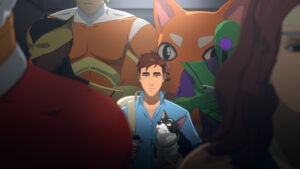Post-apocalyptic cyberpunk action games may be a dime a dozen these days, but not many possess the awesome vistas and explosive chase sequences seen in Steel Seed. Throw in a healthy dose of puzzle-platforming, and you might have something worth the asking price, provided you are willing to overlook the occasional glitch here and there.
Steel Seed is a stealth-action adventure game set in the far future where humanity has practically killed itself alongside what’s left of Earth. Players take control of Zoe, a cyborg girl who is every bit the proverbial fish out of water one would expect in this situation. Together with her flying drone buddy, Koby, they embark on a journey to decide the fate of the last remaining humans on Earth. But that process will only begin after the player locates the fragments of Dr. Archer’s consciousness that are scattered in 4 locations within the facility.
In broad terms, Steel Seed is best described as an action-adventure game with Souls-like mechanics. The facility Zoe finds herself in is massive, possibly on the same scale as a modern city. This necessitates the need for teleporters, or in this case, S4VI Points. Each teleporter is a self-contained area patrolled by several AI guards. This is where the Souls-like comparisons enter. Every time you use the S4VI point to heal yourself, patrols are redeployed into the area. It’s like using a bonfire and resetting the world state.
The combat is nothing to write about. Zoe’s beamsword only has one light combo that you will continuously spam the whole game. She does have a couple of options when it comes to her heavy attacks, but those can only be acquired after completing combat challenges. You will need those upgrades since combat is relatively deadly, even on normal difficulty. One full combo from a melee unit is enough to outright kill you, so you’ll need fast reflexes to dodge and find openings for a counterattack.
Koby also has a handful of support abilities that it can use to aid you in combat. Koby is capable of deploying stun fields, EMP fields, and even a glitch field. The glitch field acts as tall grass in any other game. It allows you to sneak close to enemies without them noticing you. It’s a bit cliche, but I don’t particularly mind its inclusion in the game.
The most interesting part of the upgrade process is unlocking the skills themselves. They serve to break up the monotony of performing the same stealth moves and allow you to experiment with effectively taking out enemies. The challenges themselves aren’t too time-consuming. However, others require upgrades on separate tech trees to be easily unlocked.
I have a sneaking suspicion that the game was primarily supposed to revolve around stealth. Stealth kills are usually the preferred option to deal with a room full of enemies. It just makes getting through so much easier compared to spamming attacks on enemies that require more than one full combo to destroy. It’s good, then that the vast majority of encounters can be completed by slipping past unaware enemies.
There are a couple of ambushes where you’ll need to kill enemies to advance, but that happens only very late into the campaign. These encounters almost feel tacked on, actually. I feel like the game would have been OK without them. One of the encounters even bugged out on me and spawned enemies behind a locked door. I was stuck, so I had no choice but to reload to a previous save.
The platforming in this game reminds me of the earlier God of War games. You go between yellow neon colored handholds to cross wide gaps. There’s an entire puzzle platforming section dedicated to shifting chained weights while you’re on it. Maybe that’s where it reminded me of God of War. Later on, Zoe unlocks her hover ability, which greatly helps in crossing great distances. But it’s still going to be climbing and jumping onto platforms to the end of the game.
I actually like the platforming segments since you are afforded a lot of wiggle room while in the air, and Zoe magnetizes to the nearest handhold. This little feature saved me on more than a few occasions of badly timed jumps. I can’t explain it, but sometimes the jumps don’t have momentum. It’s as if Zoe stumbled her pinky toe before lift off, resulting in a weak jump. It doesn’t happen often, but it happens often enough that it’s noticeable. It’s annoying but definitely not a deal breaker.
I can’t really say there’s much in the way of exploration. There are hidden data nodes and glitch caches tucked away in out-of-the-way places. The same goes for health upgrades, though they are usually hidden behind more elaborate puzzles that require Koby’s help. Being able to control Koby and see the world through its eyes really helps in uncovering secrets. Something to consider for all our completionist friends out there.
There is a distinct lack of enemy variety that becomes painfully obvious as the game progresses. Aside from the base melee and shooter enemy type, you will encounter a kamikaze unit, a Brawler, a high DPS turret, and a stealth type. That’s it. On top of that, they all have the same models for each type, with no regional variant to distinguish themselves. If you will be facing the same old enemies over and over again, they might as well look different depending on where they are stationed.
One of the more memorable parts of the game is the cat-and-mouse between Zoe and the supposed antagonist of the game, General Hogo. He and his titan pet made for some nice chase sequences. This should have been a bigger part of the game over the numerous outposts dotted around that, for some reason, are not in communication with each other.
Now, you’d think that the chase will ultimately end with an epic showdown to the death to see which artificial being deserves a chance to live. Yeah, that doesn’t happen. Instead, we get one boss fight at the very end of the game, and while it was for what it is, I felt like we needed more boss fights.
The visuals made a huge leap forward compared to the game’s Steam demo. It’s practically a night and day difference on PC. The lighting is better, and the background is gorgeous, with all the machines fulfilling various tasks. Heck, even Zoe’s armor looks a lot better now.
Zoe’s voice actress did an admirable job playing the character as one of the few voiced roles in the game (not counting those that are supposed to sound robotic). Narrative single-player games like this do better with good voice acting, and it’s nice that I didn’t go through the game with a silent protagonist. Just don’t get Koby destroyed too many times.
I wish I had the level of praise for the game’s story direction. I’m sorry, but you can see the twist coming a mile away. Thankfully, the reveal played out better than I expected. The biggest surprise was the revelation around the mid-point of the game when we found out who created the S4VI points. Spoiler alert: it’s not S4VI nor General Hogo. This alone got me thinking of what it took to get to this point and the struggles involved.
Steel Seed is a generally well put-together stealth action adventure game. Its runtime may not go beyond 15 hours in one playthrough, there is some room for collectibles and such. The game could have easily fallen into the high-visual, zero gameplay trap I’ve seen so many times before, but the game managed to go a step further and performed better than I initially expected. It’s not the best in any shape or form, but it is good. Solidly so. If you’re looking for a different experience, you may want to give the demo a shot before considering buying the full game.
This review is based on a PC review code provided by the publisher/developer.
Metal Seed Review
Steel Seed is a generally well put-together stealth action adventure game. It could have easily fallen into the high-visual, zero gameplay trap I've seen so many times before, but the game managed to go a step further and performed better than I initially expected
The Good
- Visually impressive
- Interesting puzzles
- Meaningful upgrades
- Surprising scripted moments
The Bad
- Questionable Enemy AI
- Hit-or-miss platforming
- Lack of enemy variety
- Tiresome repeat encounters











